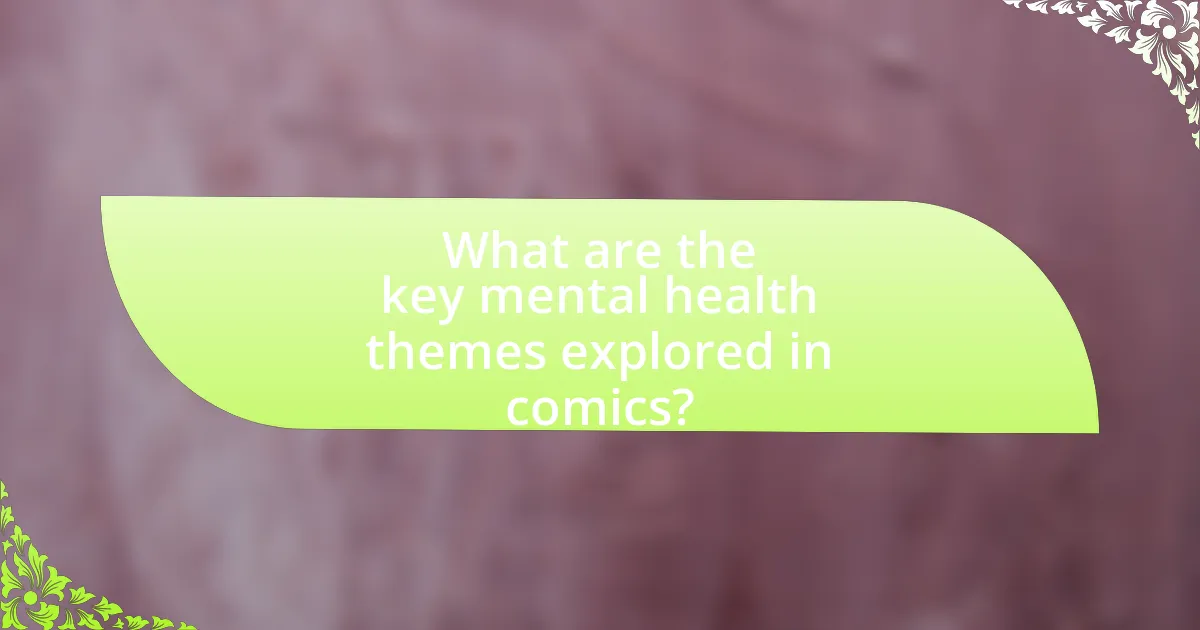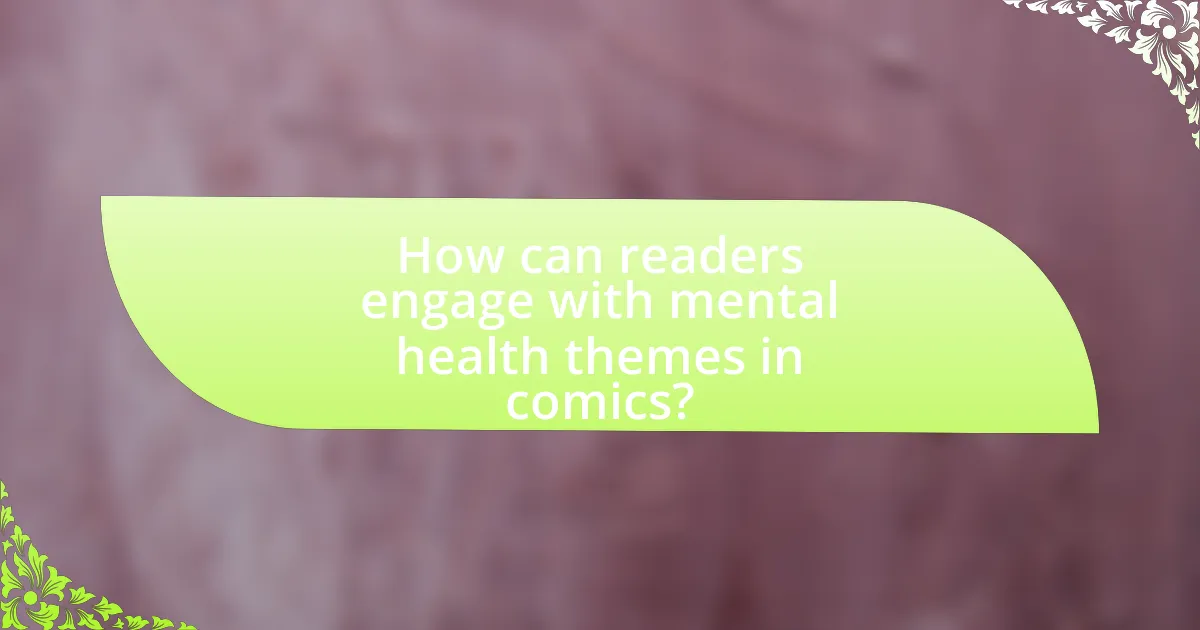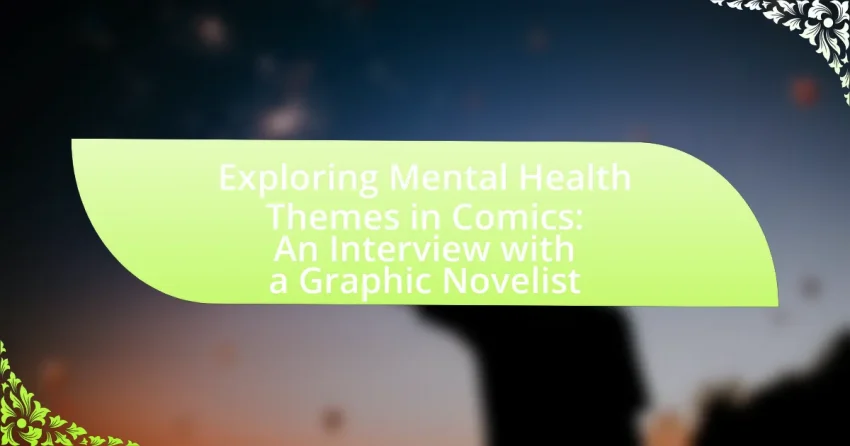The article focuses on the exploration of mental health themes in comics, highlighting key issues such as depression, anxiety, trauma, identity, and resilience. It examines how graphic novels portray these conditions through visual storytelling, providing relatable narratives that foster empathy and understanding among readers. The discussion includes insights from graphic novelists about their creative processes, the challenges they face in accurately depicting mental health, and the impact of their work on public perception. Additionally, the article offers practical tips for readers on engaging with mental health themes in comics and identifies resources for further exploration of this subject.

What are the key mental health themes explored in comics?
Key mental health themes explored in comics include depression, anxiety, trauma, identity, and resilience. Comics often depict characters grappling with these issues, providing a visual narrative that resonates with readers. For instance, works like “Fun Home” by Alison Bechdel illustrate the complexities of mental health through personal experiences of depression and family dynamics. Similarly, “The Complete Maus” by Art Spiegelman addresses trauma and its generational impact, showcasing how mental health issues can be intertwined with historical events. These narratives not only raise awareness but also foster empathy and understanding among audiences.
How do graphic novels portray mental health issues?
Graphic novels portray mental health issues by using visual storytelling to depict the complexities of mental health experiences. They often illustrate characters’ internal struggles through imagery, symbolism, and dialogue, making abstract concepts like anxiety, depression, and trauma more relatable. For instance, works like “Fun Home” by Alison Bechdel and “Marbles” by Ellen Forney provide personal narratives that explore the impact of mental illness on identity and relationships, effectively humanizing these experiences. Research indicates that graphic novels can foster empathy and understanding, as they allow readers to engage with mental health topics in a nuanced and accessible manner.
What specific mental health conditions are commonly represented?
Commonly represented mental health conditions in comics include depression, anxiety disorders, bipolar disorder, schizophrenia, and post-traumatic stress disorder (PTSD). These conditions are often depicted to illustrate the struggles and experiences of individuals, providing insight into their emotional and psychological challenges. For instance, studies show that graphic novels like “Marbles” by Ellen Forney effectively portray bipolar disorder, while “Fun Home” by Alison Bechdel addresses themes of depression and anxiety, highlighting the impact of these conditions on daily life and relationships.
How do characters in comics reflect real-life mental health struggles?
Characters in comics reflect real-life mental health struggles by portraying complex emotional experiences and psychological challenges that resonate with readers. For instance, characters like Batman exhibit symptoms of trauma and depression stemming from childhood loss, illustrating how grief can manifest in various behaviors and coping mechanisms. Additionally, works such as “Persepolis” by Marjane Satrapi depict the impact of war and displacement on mental health, showcasing anxiety and identity crises. These representations provide a narrative framework that allows readers to understand and empathize with mental health issues, making the struggles more relatable and visible in society.
Why is it important to address mental health in comics?
Addressing mental health in comics is important because it fosters understanding and reduces stigma surrounding mental health issues. Comics have the unique ability to convey complex emotions and experiences visually and narratively, making them accessible to a wide audience. By depicting characters with mental health challenges, comics can educate readers about these issues, promote empathy, and encourage conversations that might otherwise be avoided. Research indicates that storytelling, particularly through visual mediums, can significantly impact attitudes toward mental health, as seen in studies like “The Impact of Graphic Novels on Mental Health Awareness” published in the Journal of Graphic Medicine, which highlights how narratives can influence perceptions and reduce stigma.
What impact can comics have on public perception of mental health?
Comics can significantly influence public perception of mental health by providing relatable narratives that demystify mental health issues. Through storytelling and visual representation, comics can foster empathy and understanding, making complex topics more accessible. For instance, studies have shown that graphic novels addressing mental health, such as “Marbles” by Ellen Forney, have been effective in reducing stigma and encouraging open discussions about mental health challenges. This impact is further supported by research indicating that visual media can enhance emotional engagement, leading to greater awareness and acceptance of mental health conditions in society.
How can storytelling in comics foster empathy and understanding?
Storytelling in comics fosters empathy and understanding by presenting complex emotional experiences through visual narratives that engage readers on multiple levels. The combination of imagery and text allows for a nuanced portrayal of characters’ thoughts and feelings, making it easier for readers to connect with their struggles and perspectives. Research indicates that visual storytelling can enhance emotional engagement; for instance, a study published in the journal “Psychology of Aesthetics, Creativity, and the Arts” found that readers of graphic narratives reported higher levels of empathy compared to traditional text-only formats. This immersive experience encourages readers to reflect on their own emotions and the experiences of others, ultimately promoting a deeper understanding of diverse mental health themes.

What insights can a graphic novelist provide about their work?
A graphic novelist can provide insights into the creative process, thematic exploration, and personal experiences that shape their work. They often discuss how their narratives reflect mental health themes, drawing from personal struggles or observations to create relatable characters and situations. For instance, graphic novelist Ellen Forney, in her work “Marbles: Mania, Depression, Michelangelo, and Me,” illustrates her own experiences with bipolar disorder, offering readers a nuanced understanding of mental health challenges. This firsthand perspective not only informs the storytelling but also fosters empathy and awareness among readers, making complex issues more accessible.
How does a graphic novelist approach the topic of mental health?
A graphic novelist approaches the topic of mental health by integrating personal experiences and research into their narratives, often using visual storytelling to convey complex emotions and situations. This method allows them to depict mental health issues authentically, making them relatable and accessible to readers. For instance, graphic novels like “Fun Home” by Alison Bechdel explore themes of depression and identity through a blend of autobiographical elements and artistic expression, illustrating the impact of mental health on personal relationships. Such works often aim to destigmatize mental health discussions, providing insight and fostering empathy among audiences.
What personal experiences influence their storytelling?
Personal experiences that influence storytelling in graphic novels often include the author’s own struggles with mental health, family dynamics, and significant life events. For instance, many graphic novelists draw from their experiences with anxiety or depression, using these themes to create relatable characters and narratives. This connection to personal challenges allows authors to authentically portray emotional journeys, as seen in works like “Fun Home” by Alison Bechdel, where her experiences with her father’s mental health and her own identity shape the narrative. Such autobiographical elements provide depth and resonance, making the storytelling more impactful for readers.
How do they balance narrative and sensitivity in their work?
They balance narrative and sensitivity in their work by carefully integrating personal experiences with mental health themes while ensuring respectful representation. This approach allows them to create relatable stories that resonate with readers, fostering understanding and empathy. For instance, they often conduct thorough research and consult mental health professionals to accurately portray experiences, which enhances the authenticity of their narratives. This method not only engages the audience but also promotes awareness and reduces stigma surrounding mental health issues.
What challenges do graphic novelists face when depicting mental health?
Graphic novelists face significant challenges when depicting mental health, primarily due to the complexity of accurately representing nuanced psychological experiences. These creators must balance authenticity with sensitivity, as misrepresentation can perpetuate stigma or misunderstandings about mental health conditions. For instance, the portrayal of mental illness often requires a deep understanding of various disorders, which can be difficult to convey visually and narratively without oversimplifying or sensationalizing the issues. Additionally, graphic novelists may encounter difficulties in addressing the emotional weight of mental health topics while maintaining reader engagement, as heavy themes can alienate audiences if not handled with care.
How do they navigate stigma and misconceptions in their narratives?
They navigate stigma and misconceptions in their narratives by incorporating authentic personal experiences and relatable characters that challenge stereotypes. Graphic novelists often depict mental health issues with nuance, illustrating the complexities of these experiences rather than reducing them to clichés. For instance, by showcasing characters who struggle with mental health in everyday situations, they foster empathy and understanding among readers. This approach not only humanizes the subject but also encourages open dialogue about mental health, effectively countering prevalent misconceptions.
What feedback have they received from readers regarding mental health themes?
Readers have expressed appreciation for the authentic representation of mental health themes in the graphic novelist’s work. Feedback highlights that the portrayal resonates deeply with their personal experiences, fostering a sense of connection and understanding. Many readers report feeling validated and less isolated in their struggles, indicating that the themes addressed are both relatable and impactful. This positive reception underscores the importance of mental health narratives in comics, as they provide not only entertainment but also a platform for dialogue and awareness.

How can readers engage with mental health themes in comics?
Readers can engage with mental health themes in comics by actively analyzing the narratives and characters that depict mental health issues. This engagement allows readers to reflect on their own experiences and understand diverse perspectives on mental health. Research indicates that comics can serve as effective tools for empathy-building, as they visually represent complex emotions and situations, making them more relatable. For instance, studies have shown that graphic novels addressing mental health can reduce stigma and promote awareness, encouraging discussions around these topics.
What are some recommended graphic novels that address mental health?
Some recommended graphic novels that address mental health include “Fun Home” by Alison Bechdel, which explores themes of depression and identity through the lens of family dynamics. “Marbles: Mania, Depression, Michelangelo, and Me” by Ellen Forney provides a personal account of living with bipolar disorder, illustrating the challenges and triumphs of mental illness. “The Prince and the Dressmaker” by Jen Wang touches on themes of gender identity and self-acceptance, highlighting the emotional struggles faced by its characters. “My Friend Dahmer” by Derf Backderf examines the early life of serial killer Jeffrey Dahmer, offering insights into the impact of mental health issues on his development. Each of these works has been recognized for their poignant storytelling and ability to foster understanding of mental health challenges.
How can readers identify authentic representations of mental health in comics?
Readers can identify authentic representations of mental health in comics by examining the depth and accuracy of character experiences, the portrayal of mental health conditions, and the inclusion of realistic coping mechanisms. Authentic comics often feature characters whose struggles are depicted with nuance, reflecting real-life complexities rather than stereotypes. For instance, works like “Marbles” by Ellen Forney provide insight into bipolar disorder through personal narrative and research, showcasing both the challenges and the management of the condition. Additionally, comics that consult mental health professionals or incorporate lived experiences tend to offer more credible representations, as seen in “The Complete Maus” by Art Spiegelman, which addresses trauma and its effects on mental health through a historical lens.
What practical tips can readers apply when exploring mental health themes in comics?
Readers can apply several practical tips when exploring mental health themes in comics. First, they should approach the material with an open mind, allowing for personal interpretation and emotional connection to the characters’ experiences. Engaging with diverse narratives can enhance understanding; for instance, comics like “Fun Home” by Alison Bechdel provide insight into complex mental health issues through personal storytelling. Additionally, readers can reflect on their own feelings and thoughts while reading, which can foster a deeper connection to the themes presented. Research indicates that engaging with art can improve emotional well-being, making this a beneficial practice. Lastly, discussing the comics with others can provide different perspectives and enhance comprehension of the mental health themes explored.
How can readers use comics as a tool for self-reflection and understanding?
Readers can use comics as a tool for self-reflection and understanding by engaging with the visual narratives that often depict complex emotional experiences and mental health themes. Comics combine imagery and text, allowing readers to visualize their feelings and thoughts, which can facilitate deeper introspection. Research indicates that visual storytelling can enhance empathy and emotional processing, as seen in studies like “The Impact of Graphic Novels on Empathy Development” by Marissa L. Cohen and colleagues, which found that readers of graphic novels showed increased empathy towards characters facing mental health challenges. This engagement with relatable characters and situations can prompt readers to reflect on their own experiences, fostering a greater understanding of their emotions and mental health.
What resources are available for further exploration of mental health in graphic novels?
Resources for further exploration of mental health in graphic novels include academic journals, online databases, and specific graphic novels that address mental health themes. Academic journals such as “The Journal of Graphic Novels and Comics” publish research on the intersection of mental health and graphic storytelling. Online databases like JSTOR and Google Scholar provide access to scholarly articles discussing mental health representations in graphic novels. Notable graphic novels that explore these themes include “Fun Home” by Alison Bechdel, which addresses issues of identity and mental health, and “Marbles: Mania, Depression, Michelangelo, and Me” by Ellen Forney, which provides a personal narrative on bipolar disorder. These resources collectively offer a comprehensive understanding of how mental health is depicted and explored in graphic novels.
